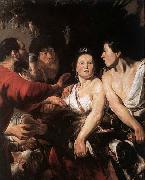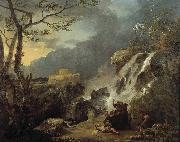Wholesale Oil Painting Reproductions No Minimum and Door to Door! |
|||||||||||
|
|
|||||||||||

|
|||||||||||
|
|
|
||||||||
All JORDAENS, Jacob Oil Paintings |
||||||||
|
|
||||||||
|
|
||||||||
|
Artist Introduction: Flemish painter (b. 1593, Antwerpen, d. 1678, Antwerpen).
Flemish painter, tapestry designer and draughtsman. In the context of 17th-century Flemish art, he emerges as a somewhat complicated figure. His oeuvre, the fruit of a continual artistic development, is characterized by great stylistic versatility, to which the length of his career contributed. His religious, mythological and historical representations evolved from the rhetorical prolixity of the Baroque into a vernacular, sometimes almost caricatural, formal idiom. The lack of idealistic treatment in his work is undoubtedly the factor that most removed Jordaens's art from that of his great Flemish contemporaries Rubens and van Dyck. Jordaens's officially commissioned works included many paintings in which the sublimity of the subject-matter clashed with the vulgarity of some of his figures. Unlike Rubens and van Dyck, both of whom were knighted in the course of their careers, Jordaens was, in fact, completely ignored by the courts of Spain and Brussels |
||||||||
|
|
||||||||
|
Meleager and Atalanta Painting ID:: 51058 |
1618
Oil on canvas,
152 x 120 cm |
|||||||
Height Width |
INS/CM Quality |
|||||||
|
X |
| |||||||
|
|
||||||||
All Richard Wilson Oil Paintings |
||||||||
|
|
||||||||
|
|
||||||||
|
Artist Introduction: Welsh Romantic Painter, ca.1713-1782
was a Welsh landscape painter, and one of the founder members of the Royal Academy in 1768. Wilson has been described as '...the most distinguished painter Wales has ever produced and the first to appreciate the aesthetic possibilities of his country.' Wilson is considered to be the father of landscape painting in Britain. The son of a clergyman, Wilson was born in Penegoes, Montgomeryshire. The family was an old and respected one, and Wilson was first cousin to Charles Pratt, 1st Earl Camden. In 1729 he went to London where he began as a portrait painter, under the apprentership of an obscure artist, Thomas Wright. From 1750 to 1757 he was in Italy and adopted landscape on the advice of Francesco Zuccarelli. Painting in Italy and afterwards in England, he was the first major British painter to primarily concentrate on landscape. He composed well, but saw and rendered only the general effects of nature thereby creating a personal, ideal style influenced by Claude Lorrain and the Dutch landscape tradition. According to John Ruskin, he "paints in a manly way, and occasionally reaches exquisite tones of colour." He concentrated on painting Italianate landscapes and landscapes based upon classsical literature, but when his painting The Destruction of the Children of Niobe (c.1759-60) won high acclaim he gained many commissions from wealthy families seeking classical potrayals of their estates. |
||||||||
|
|
||||||||
|
|
Meleager and Atalanta Painting ID:: 89165 |
c. 1770(1770)
Medium oil on canvas
Dimensions Height: 1,045 cm (411.4 in). Width: 1,295 cm (509.8 in).
cjr |
||||||
Height Width |
INS/CM Quality |
|||||||
|
X |
| |||||||
|
|
||||||||
|
Prev Next
|
||||||||
|
|
||||||||
|
Related Paintings to Richard Wilson :. |
||||||||
|
|
||||||||
|
CONTACT US |


